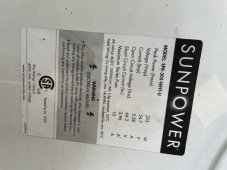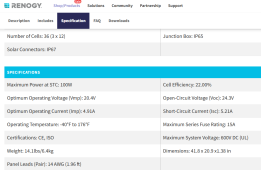Here is a strategy that might work for you. Both the amperages and the voltages of these panels are too widely divergent for them to be used either in parallel or serially with one single controller. As RNT describes, buying two controllers will work, but a second option is to buy a second panel that brings the voltages to within 5% of each other.
The difference between the two panels is 54.7V - 34.1V = 20.6. So, if you wire a second 20V panel in series with your 335W panel you will match voltages closely. The problem with panels in series though is that amperages need to match closely. If they do not, the net amperage will be only that of the panel in the string with the lowest amperage.
But, here is an example of a 200W panel that fits these parameters fairly well. If you wired this 200W Renogy panel in series with your 335W panel you would get 34.1V + 22.6V = 56.7V. That is only 3.6% difference, well within the 5% limit. The amperage of this new panel is 8.85A, which is only 0.95A different.
So, if you made the series string of the 335W panel with the 200W panel, and then put that in parallel with your 305W panel, you'd get about 8.85A + 5.58A = 14.43A flowing into the controller at ~ 55.7V (not exact).
An MPPT controller would convert the high raw solar voltage down to battery charging voltage. For a 12V battery, that would be 64A, or 32A into a 24V battery. Expect that to be 54A or 27A respectively in the real-world. So for 12V, you would need at least a 60-80A controller, such as Epever's Tracer 6415AN or 8415AN, or the cheaper Tracer 4210AN if you went with a 24V system.
So now, what you would need to decide is whether you want to go with the one controller-two controller strategy or with the one controller, variable amperage strategy. Do the math and see what the most cost-effective strategy works best for you? If you shop around and look for additional panels in the 20V range, you might find a better fit than my quicky search.
View attachment 139998







